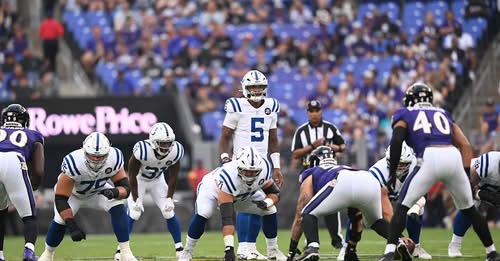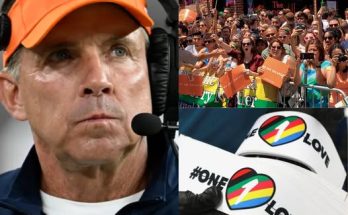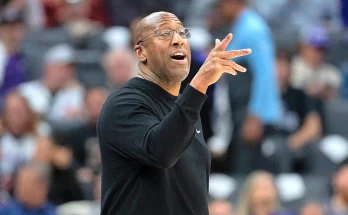Preseason football is supposed to be a time for players to shake off the offseason rust, integrate new teammates, and give coaches a glimpse of their readiness for the regular season. For Indianapolis Colts quarterback Anthony Richardson Sr., however, the 2025 preseason opener quickly turned into a scene of frustration and concern for both the player and the franchise. In a game that promised excitement and the potential for Richardson to showcase his unique athleticism and arm talent, the young quarterback suffered a finger injury in the first quarter and was forced to exit the contest, leaving fans and analysts alike questioning the immediate implications for the Colts’ offensive plans.
The incident occurred during a sequence that was otherwise unremarkable until Richardson attempted a throw under pressure from the opposing defense. In what appeared to be routine mechanics, Richardson’s throwing finger came into awkward contact with a defender’s hand, resulting in a visible reaction of pain and immediate attention from the Colts’ medical staff. While the team initially allowed him to briefly attempt to shake off the discomfort, it became evident within minutes that the injury was serious enough to prevent him from returning to the field for the remainder of the game. This sudden turn of events underscored the unpredictable nature of preseason football, where the intensity may be moderated but the physical stakes remain high.
Anthony Richardson, entering his second season in the NFL, has been a focal point for the Colts since being drafted. Known for his explosive athleticism, dual-threat capability, and strong arm, Richardson quickly became a symbol of the Colts’ long-term quarterback plans. His rookie campaign showed glimpses of brilliance but also highlighted areas needing improvement, including decision-making under pressure and accuracy on intermediate throws. As a result, this preseason opener carried additional weight for Richardson, as it was an opportunity to solidify his role as the undisputed starter, demonstrate growth, and build chemistry with a retooled offensive line and receiving corps.
The timing of the injury could not have been more challenging. With the regular season looming, Richardson’s availability for upcoming preseason games and early-season preparations is now uncertain. Colts head coach Frank Reich addressed the situation with measured concern during the post-game press conference, emphasizing the need to prioritize the player’s health while remaining optimistic about his recovery timeline. “Anthony is obviously dealing with a finger injury that we’re evaluating closely,” Reich stated. “Our medical team is working on it, and we’ll make sure he has the proper care and rehab. He’s a resilient player, and we’ll do everything we can to get him back on the field as soon as it’s safe.”
Finger injuries, particularly for quarterbacks, carry a unique set of challenges. The mechanics of throwing, gripping the ball, and executing precise passes are all directly affected by even minor finger damage. Historical precedent in the NFL shows that while some quarterbacks return quickly from finger sprains or fractures, others may experience lingering effects that impact accuracy and confidence. For a young quarterback like Richardson, whose game relies on both velocity and precision, proper healing is critical. Colts’ medical staff reportedly conducted imaging tests immediately following the injury to determine the severity and rule out fractures or ligament damage, though no official diagnosis has been released publicly.
The Colts’ offensive staff is now faced with the task of adjusting practice plans and possibly game strategies while Richardson recovers. Backup quarterbacks on the roster, including veteran presence and younger developmental talent, are expected to receive increased reps in practice sessions and potentially more playing time in upcoming preseason contests. While Richardson’s absence is a setback, it also provides the coaching staff with an opportunity to evaluate depth at the quarterback position and test offensive schemes with alternate personnel. Nevertheless, the long-term plan for the franchise remains centered around Richardson, making his recovery a priority both physically and strategically.
Fan reaction to the news was swift and intense. Social media platforms were flooded with messages of support, concern, and speculation regarding the severity of the injury. Colts fans, who have been energized by Richardson’s dynamic playmaking ability, expressed hope for a quick recovery while acknowledging the risk of a disrupted preseason routine. Analysts and commentators also weighed in, noting that while preseason injuries are not uncommon, the timing for a young quarterback in a developing offense is particularly critical. The consensus among experts is that Richardson’s ability to heal without rushing back will be essential to maintain momentum heading into the regular season.
In addition to physical implications, injuries of this nature can have mental and emotional effects on players. Quarterbacks often carry a unique level of responsibility for their team’s performance, and being sidelined can be frustrating and stressful. Maintaining focus, confidence, and engagement with the team while recovering is a challenge that requires both personal resilience and strong support from coaches, teammates, and medical staff. Richardson, known for his competitive mindset and leadership qualities, is expected to embrace rehabilitation and continue mental preparation, even while unable to participate fully on the field.
From a broader organizational perspective, Richardson’s injury also highlights the delicate balance NFL teams must maintain between player development, game evaluation, and health preservation during the preseason. While teams naturally want to see their young stars perform and gain experience, protecting players from potential long-term injury is a paramount concern. The Colts, like many franchises, face the challenge of optimizing playing time to assess talent while minimizing risk, particularly for quarterbacks whose health is central to the team’s success.
Looking ahead, Richardson’s recovery timeline will be closely monitored by both the Colts organization and the league at large. Early reports suggest that while the injury is significant enough to sideline him for the remainder of the opener, there is optimism about a relatively short-term recovery, contingent on the absence of fractures or severe ligament damage. Colts fans and analysts alike will be watching for updates on practice participation, physical therapy progress, and potential returns in subsequent preseason games. The team’s medical updates and coaching decisions in the coming days will be instrumental in determining how Richardson reintegrates into the offense.
This incident also serves as a reminder of the inherent unpredictability of professional football. Even in preseason, where the intensity and stakes are lower than regular-season contests, injuries can occur at any moment and affect both individual players and team dynamics. For Anthony Richardson Sr., this unexpected setback is a test of resilience, determination, and ability to maintain focus on long-term goals despite immediate challenges. How he navigates this period of recovery and returns to the field will likely shape both his personal trajectory and the Colts’ offensive outlook for the 2025 season.
In conclusion, the Colts’ preseason opener took a dramatic and concerning turn when Anthony Richardson Sr. sustained a finger injury in the first quarter and was forced to leave the game, unable to return. The impact of this injury spans physical, strategic, and emotional dimensions, affecting both the player’s development and the team’s preparation for the regular season. While the full severity of the injury remains under evaluation, the Colts are prioritizing Richardson’s recovery and long-term health. Fans, coaches, and analysts will be watching closely as the young quarterback works through rehabilitation, with the hope that he will return to the field stronger, ready to lead the Colts with the dynamic playmaking ability that has made him one of the most intriguing young quarterbacks in the league. The preseason setback, though disappointing, may ultimately serve as a crucial learning and resilience-building moment for Richardson, setting the stage for a determined and focused return as the regular season approaches.


